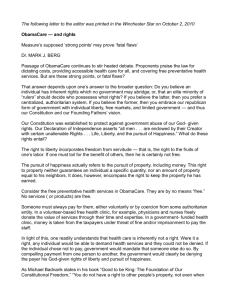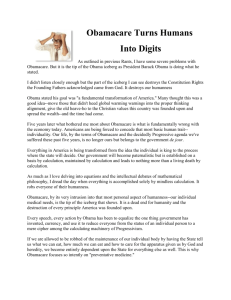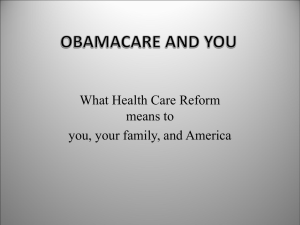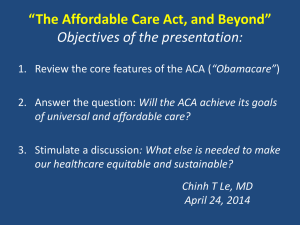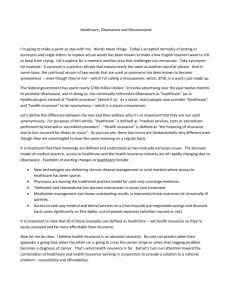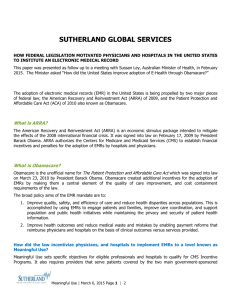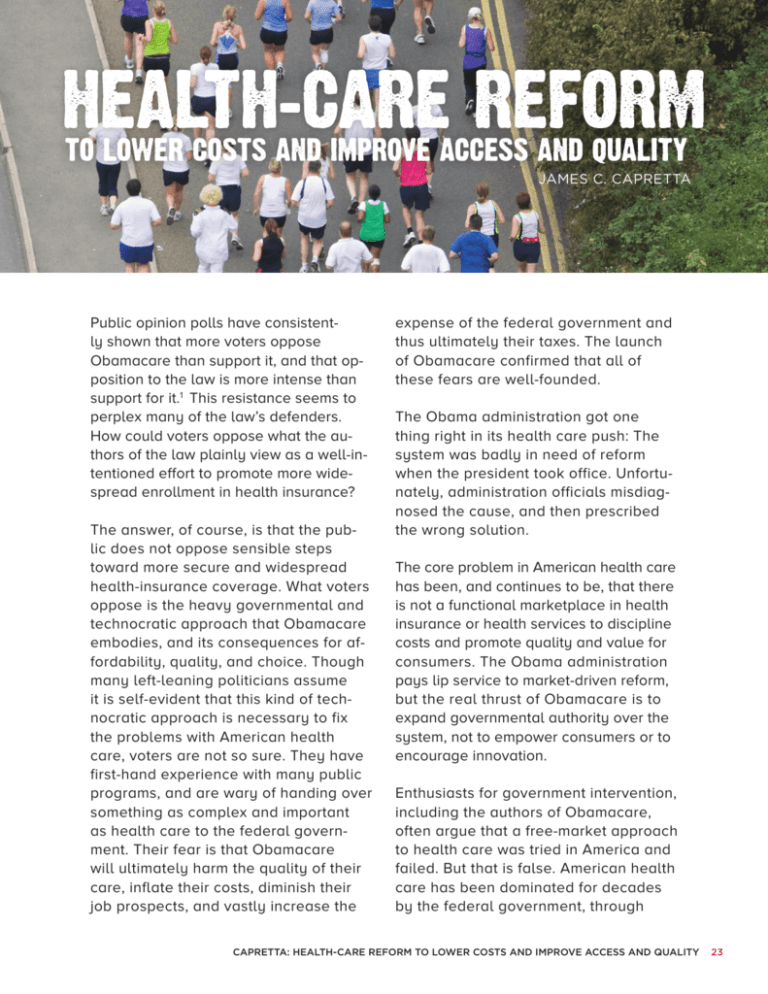
JAMES C. CAPRETTA
Public opinion polls have consistently shown that more voters oppose
Obamacare than support it, and that opposition to the law is more intense than
support for it.1 This resistance seems to
perplex many of the law’s defenders.
How could voters oppose what the authors of the law plainly view as a well-intentioned effort to promote more widespread enrollment in health insurance?
The answer, of course, is that the public does not oppose sensible steps
toward more secure and widespread
health-insurance coverage. What voters
oppose is the heavy governmental and
technocratic approach that Obamacare
embodies, and its consequences for affordability, quality, and choice. Though
many left-leaning politicians assume
it is self-evident that this kind of technocratic approach is necessary to fix
the problems with American health
care, voters are not so sure. They have
first-hand experience with many public
programs, and are wary of handing over
something as complex and important
as health care to the federal government. Their fear is that Obamacare
will ultimately harm the quality of their
care, inflate their costs, diminish their
job prospects, and vastly increase the
expense of the federal government and
thus ultimately their taxes. The launch
of Obamacare confirmed that all of
these fears are well-founded.
The Obama administration got one
thing right in its health care push: The
system was badly in need of reform
when the president took office. Unfortunately, administration officials misdiagnosed the cause, and then prescribed
the wrong solution.
The core problem in American health care
has been, and continues to be, that there
is not a functional marketplace in health
insurance or health services to discipline
costs and promote quality and value for
consumers. The Obama administration
pays lip service to market-driven reform,
but the real thrust of Obamacare is to
expand governmental authority over the
system, not to empower consumers or to
encourage innovation.
Enthusiasts for government intervention,
including the authors of Obamacare,
often argue that a free-market approach
to health care was tried in America and
failed. But that is false. American health
care has been dominated for decades
by the federal government, through
CAPRETTA: HEALTH-CARE REFORM TO LOWER COSTS AND IMPROVE ACCESS AND QUALITY
23
vast subsidies for insurance
and through payment regulations shaping the provision of medical services by
hospitals and doctors. The
result was a system dominated by third-party insurance
arrangements, not consumer
choice, and by federal regulations setting the terms for
reimbursing hospitals
and physicians.
Enthusiasts for government intervention,
including the authors of Obamacare,
often argue that a free-market approach to
health care was tried in America and failed.
But that is false. American health care
has been dominated for decades by the
federal government, through vast subsidies
for insurance and through payment
regulations shaping the provision of
medical services by hospitals and doctors.
Providers were often
restricted from trying new
approaches to organizing and financing
coverage and care, most consumers did
not have the power to choose among
real options, and failed price-control
systems in massive federal programs
persisted despite a proven inability to
control costs. In sum, American health
care before Obamacare was very far
from a genuine marketplace.
Looking at that landscape in 2009, the
Obama administration came into office and somehow concluded that the
problem with American health care was
insufficient governmental involvement.
And so the law that was passed by a
heavily Democratic Congress in 2010
doubled down on many of the worst
features of the existing system: heavy
public subsidies for third-party insur-
ance enrollment and new and more
restrictive federal regulations governing
payments for medical services. It also
handed vast new regulatory authority
over the insurance sector to the Department of Health and Human Services
and empowered new federal agencies
and bureaucracies to step up the
government’s influence and control over
the manner in which doctors and hospitals organize themselves to care for
patients. All this tends to make it even
more difficult for providers and insurers
to try new approaches, for consumers to
make real choices among real options,
and for bad ideas to be abandoned.
In short, Obamacare was a step in
exactly the wrong direction. More than
anything else, the law set in motion
a massive shift of decision-making
authority from states,
employers, insurers, and
In short, Obamacare was a step in exactly
consumers to the federal
government. In a way, that
the wrong direction. More than anything
was the point. The authors
else, the law set in motion a massive shift
of the law believe that
of decision-making authority from states, muscular federal control
is essential to expanding
employers, insurers, and consumers to the coverage in an
equitable manner.
federal government.
24
YG NETWORK
ROOM TO GROW: CONSERVATIVE REFORMS FOR A LIMITED GOVERNMENT AND A THRIVING MIDDLE CLASS
But average middle-class families do not expect this shift of power to do anything
to help them, especially with respect to rising health costs, which are their chief
concern. From 2000 to 2012, median household income rose at an average annual
rate of just 1.6 percent, according to the Census Bureau. During that same period,
per-capita health spending rose at an average annual rate of 5.3 percent. Rising
health costs have contributed directly to the stagnation of cash compensation as
employers have kept pay raises low in response to the rising costs of employee
health benefit plans. Obamacare’s substantial new subsidies for third-party insurance
look likely to increase cost pressures, not decrease them.
Average Annual Growth Rates (Nominal),
2000 to 2012
6%
5.3%
5%
4%
3%
2%
1%
1.6%
0%
Median Income
Per Capita Health Spending
Sources: U.S. Census Bureau; Personal Health Care Consumption Estimates, National Health
Expenditure Accounts, Center for Medicare and Medicaid Services
The centralization of power within the
federal government, and specifically
within HHS, will also have serious negative consequences for the quality of the
health system. Government rulemaking
and demonstration projects have already begun to displace private initiative. Instead of taking the lead to solve
problems and improve care, the major
players in the health system—employers,
states, providers, and insurers—are now
waiting for the latest pronouncements
from HHS about what is and is not
acceptable under Obamacare. Over
time, it will become more difficult to find
investment capital for initiatives that
have to be given regulatory approval by
the government. The spreading passivity
among private actors will undermine
innovation and adaptation, and thus
also hinder improvements in the quality
of care for patients.
The economic costs of the law are
also coming into sharper focus. The
Congressional Budget Office (CBO)
recently issued new estimates for the
law’s impact on the labor market, and
CAPRETTA: HEALTH-CARE REFORM TO LOWER COSTS AND IMPROVE ACCESS AND QUALITY
25
found that it will reduce employment
in the United States by the equivalent
of some 2.5 million workers by 2024.2
CBO’s new projections also show that,
even after a ten-year gross expenditure
of $2 trillion, the number of uninsured
Americans will still total 31 million in
2021 and beyond.3
For all of these reasons, public unease
with the 2010 reform plan has grown,
not receded, since the law was enacted.
And therein lies an historic opportunity.
The Opening for an Appealing
Conservative Alternative
Conservatives are united in their belief
that Obamacare needs to be repealed.
There is also near unanimity that the
law needs to be replaced with an effective, market-based alternative. But there
is still a great deal of disagreement
among conservatives about the content
of that alternative plan.
There shouldn’t be.
If a plan is to appeal to middle-class
Americans—as it must to gain traction—
then it will need to address middle-class
concerns, and particularly the need
to provide coverage for persons with
pre-existing health conditions, to ensure
all Americans have access to stable
insurance, and to slow the pace of
rising costs. These objectives need to
be met without increasing the deficit
and without handing over too much
power to the federal government, as
Obamacare would do.
It will also be necessary to have independent verification—in practice that
means by the Congressional Budget
Office—that a replacement plan could
address these issues in a credible
26
YG NETWORK
way. For instance, if a plan to replace
Obamacare is found by CBO to do little
or nothing to reduce the number of uninsured Americans, it is unlikely to get the
political momentum necessary to fully
displace Obamacare.
These objectives will narrow the policy
options available to policymakers. Lower-income households will need public
subsidies, for example, to be able to
secure at least catastrophic insurance
coverage and participate in a thriving
consumer market, and those subsidies
will have a budgetary cost. The new plan
will also have to be designed so as not
to unduly disrupt the insurance arrangements of the millions of middle-class
families who now have coverage they are
happy with.
Some conservatives get nervous at the
prospect of engaging in this kind of
policy discussion. They would prefer to
repeal Obamacare and then proceed
with a series of very small, incremental
changes to the pre-Obamacare health
system. But that approach is unlikely
to succeed because it will be criticized
as undoing protections for pre-existing
conditions and doing nothing to help
low-income households without health
insurance. It also falls short of the significant step toward a market-oriented
system that we should take.
Conservatives must see the present opportunity, provided by Obamcare, clearly. We have an opportunity to move
our health-care system to the right
not only of Obamacare but also of the
pre-Obamacare status quo. The middle
class is ready to hear from conservatives
about their practical and realistic proposals to improve their lives. If conservatives seize the political moment, they
ROOM TO GROW: CONSERVATIVE REFORMS FOR A LIMITED GOVERNMENT AND A THRIVING MIDDLE CLASS
could displace the largest expansion of governmental power in a generation with a
program that would unleash, for the first time, the real potential of consumer choice
in health care. It would be the most significant conservative policy victory in many years.
Four Keys to Reform
The ideas that would inform a practical conservative alternative have been around
for many years now, developed and advanced by a cadre of health-policy analysts
and economists. All that is needed at this point is a persistent effort to pull those
ideas together in a reform plan that can appeal to America’s middle class and
around which a stable center-right political coalition can form.
In early 2014, two plans were introduced that conservatives should look to as
politically viable and credible blueprints for replacing Obamacare. The first was
released by Republican Senators Richard Burr, Tom Coburn, and Orrin Hatch.4 The
second was put together by the 2017 Project, a non-profit organization dedicated
to building and promoting a conservative reform agenda.5 Though some of the
details of these two plans differ,
and future proposals from various
We have an opportunity to move our
conservatives could well differ
health-care system to the right not only of in some key particulars too, they
Obamacare but also of the pre-Obamacare share a common structure and
vision that will likely define any
status quo. The middle class is ready to hear plausible conservative replacement for Obamacare. This structure
from conservatives about their practical
consists of four key parts: a deand realistic proposals to improve
centralized, market-oriented approach to the health-care system;
their lives.
tax credits for people outside the
employer system achieved with minimal disruption of employer coverage; continuous
coverage protection for all Americans; and significant state flexibility.
First, the basic market orientation of this approach is in a sense its overarching
characteristic. Addressing the complex problems bedeviling American health care
will require the dynamism and discipline of a functioning marketplace. Rather than
assume that bureaucrats in Washington have all the answers, such a market would
allow providers on the ground to try new ways to deliver quality care at a low cost,
would allow consumers on the ground to choose among these options to enable
incremental progress toward a better system, and would allow those approaches
that do not succeed to fall away and create both the incentives and the space for
further improvement.
The Obama administration claims that Obamacare is a marketplace, but the reality
is that it is a top-down, bureaucratic solution, with all of the critical decisions made in
Washington. HHS strictly defines the insurance product and then compels insurers to
sell it while the IRS compels consumers to buy it. That is not a market. The conservative
alternative must employ a decentralized approach, with consumers driving the system
CAPRETTA: HEALTH-CARE REFORM TO LOWER COSTS AND IMPROVE ACCESS AND QUALITY
27
by the decisions they make about insurance coverage and the use of medical
services. It must therefore feature far
less prescriptive insurance regulation and
much more room to experiment with
options for consumers to consider. A
model for these reforms can be found
in the Medicare Part D program, a real
marketplace that has restrained cost
growth while also yielding high levels of
choice and satisfaction for seniors.
Second, economists of all political
stripes have long agreed that the
open-ended tax subsidization of
employer-paid health insurance is one
of the main distortions of the existing
system. It encourages excessively
costly employer plans and discriminates
against households that do not have
access to employer coverage and thus
must rely on the individual market for
insurance. But conservatives must resist
the temptation to simply undo current
tax policy in an Obamacare replacement
plan. Approximately 160 million people
in the United States are enrolled in
employer-sponsored insurance. Any
widespread disruption of that coverage,
as a complete rewrite of the federal tax
treatment would surely involve, would
be strongly resisted by the families benefitting from that coverage and would
likely doom the entire reform effort.
A better approach, pursued in both the
Republican Senators’ plan and in the
blueprint offered by the 2017 Project,
among others, would leave in place the
tax preference for employer coverage, but
place an upper limit on the amount of
employer-paid premiums that would enjoy
tax-preferred status. This approach
would allow these plans to continue
operating as they do today, just with a
greater incentive for cost discipline. The
upper limit could be set to affect only
28
YG NETWORK
the most expensive plans (such as plans
with premiums in the top tenth or twentieth percentile, by cost).
At the same time, households that
do not have access to employer coverage should be given a tax credit that is
roughly equivalent to the value of the tax
subsidy afforded to employer-sponsored
plans. The credits could be adjusted by
age categories (such as 18 to 34, 35 to
50, and 51 to 65), so that older citizens
would get credits more reflective of
their health risks, as would younger
workers. The reform plans offered by the
Republican Senators and the 2017 Project
both provide age-adjusted credits.6 The
credits would also be entirely under
the control of the households to which
they are provided, and could be used
only to secure insurance (or, if the credit
exceeded the premium for coverage, to
deposit into a health savings account).
A tax credit of this kind would help
generate intense price competition in the
marketplace. Consumers receiving the
credit would have every incentive to find
good value in health insurance because
any premium charged by an insurance
plan above the credit would be paid by
the consumer, not the government. The
upper limit on the tax preference for
employer coverage would also encourage
both firms and workers to shop around for
good value in insurance plans.
Third, continuous-coverage protection
would help address the challenge of
covering Americans with pre-existing
medical conditions. Americans must
often switch insurance when they switch
jobs, and a law passed in 1996 has
largely worked to smooth out transition
problems between job-based plans.
Specifically, workers (or their family
ROOM TO GROW: CONSERVATIVE REFORMS FOR A LIMITED GOVERNMENT AND A THRIVING MIDDLE CLASS
members) with a pre-existing condition
can’t be penalized when they sign up
with insurance at a new job so long as
they have had insurance for a specified
period of time. Unfortunately, that law
did not adequately extend the same
protection for people who transition
from job-based coverage to individually
purchased insurance.
This gap needs to be filled in the context of a broad commitment to the
American people. Under the emerging
conservative alternative to Obamacare,
people who remain continuously insured, with at least catastrophic insurance, will never be forced to pay
high premiums solely on the basis of
developing a costly health condition.
This new assurance would provide a
powerful incentive for Americans to
stay continuously enrolled in insurance.
In combination with the new federal
tax credits for coverage (provided to
anyone without access to an employer
plan), this reform would provide a direct
and ready mechanism for all Americans
to afford insurance and to have coverage that does not penalize them for
their health conditions. Of course, for
this new system to work, insurers must
be allowed to assess the risks of those
who opt out of insurance and then seek
to enroll later in a plan.
This approach to solving the pre-existing
condition problem is more or less the
exact opposite of the approach taken
in Obamacare. Under Obamacare,
insurers are never allowed to take
health risks into account, even if someone has dropped out of insurance and
is signing up only because of a recently diagnosed condition. The law tries
to counteract the strong incentive to
wait until the last minute to enroll by
taxing anyone who fails to buy qualified insurance. This “mandate and tax”
scheme, which is a central feature of
Obamacare, is one of the main reasons
the current law is highly unpopular. By
instead putting coverage within everyone’s reach and rewarding the decision
to obtain it, a conservative reform could
cover more people while avoiding heavy
handed and constitutionally dubious
policies.
Finally, any solution to the problems in
American health care will necessarily
entail some uniform national policies.
But the plans offered by the Republican
Senators and the 2017 Project, like any
plausible conservative approach, also
leave plenty of room for states to adopt
policies suited to their needs within a
federal framework.
States are given the lead role in insurance regulation and ensuring consumers
have the information they need to make
informed choices. They also have the
lead role in Medicaid reform. In both of
the recent conservative replacement
plans for Obamacare, like others before them, Medicaid recipients would be
allowed to take the base part of their
entitlement in the form of the new federal
tax credit. States would then be allowed
to establish mechanisms by which
Medicaid enrollees use their credits, plus
any additional Medicaid support provided
by the state, to purchase from the same
coverage options as other working-age
people in the state. This is a crucially important reform, as it would allow Medicaid
participants to stay enrolled in the same
insurance plan even as they move into
higher-paying jobs.
To give states the authority they need
to make this kind of reform work, states
need to receive their Medicaid funds in
predictable and flexible per-capita payments from the federal government. This
would replace today’s cumbersome and
counterproductive matching program.
The per-capita amounts would be tied to
historical spending in the states. After the
first year, the per-capita amounts would
grow with an agreed-upon index, perhaps
measuring medical inflation.
The per-capita payments can be calibrated to be budget-neutral to the federal
government in the first year (and the tax
credits paid to Medicaid-eligible participants must be counted as part of the
federal Medicaid spending commitment).
In other words, federal payments to the
states would be equal, in the aggregate,
to expected federal spending if today’s
matching system had been retained. After
the first year, some savings would accrue
to the federal government as the per-capita payments would grow more slowly
than Medicaid spending is expected to
grow under current baseline projections.
Moving toward per-capita payments in
Medicaid would remove the distorting
effects of today’s matching system and
provide budgetary predictability at the
federal and state levels of government.
It would also allow the federal government
to give the states total discretion over
the design of the program because
state decisions could no longer increase
federal spending commitments.
States would have wide discretion over
how to design the new Medicaid program,
including full authority to establish
required benefits and other special
rules that might apply to the Medicaid
population. They would also establish
the amounts of additional premium
assistance provided through Medicaid,
30
YG NETWORK
and how that assistance would be
phased down as incomes rise.
Obamacare included many changes
to Medicare too, many of which also
deserve repeal and replacement.
Among other things, the law includes
large cuts in the Medicare Advantage
program—a counterproductive move
that will push more seniors back into
the inefficient Medicare fee-for-service
program. There are also deep cuts in
the payment systems for hospitals and
other providers of care that could cause
access problems for seniors. Most
conservatives rightly oppose this micromanagement and recognize that what
Medicare needs are reforms that point
the program in a more market-oriented
direction (like those proposed in the
House Republican budgets of the last
few years).
But reversing the damaging Medicare
changes in current law, and replacing
them with sensible reforms, need not
come in the same legislation replacing
Obamacare.7 Improving health care for
the working age population and their families is likely to prove politically challenging enough without also adding to the
mix significant Medicare reforms. Those
can and should be considered in a separate piece of legislation.
Covering Millions at a Fraction of
Obamacare’s Expense
The Obama administration has frequently cited the estimates of the Congressional Budget Office to argue that
Obamacare will deliver more enrollment
in health insurance than the previous
system, while still providing for a small
reduction in the federal budget deficit
over the program’s first decade of implementation. The administration tends
ROOM TO GROW: CONSERVATIVE REFORMS FOR A LIMITED GOVERNMENT AND A THRIVING MIDDLE CLASS
to omit that these
estimates rely on
massive cuts in
the Medicare
program ($700
billion over
a decade)
and a $1
trillion tax
increase.
By contrast,
the emerging
conservative
alternative
can deliver just
as much insurance
enrollment without the
massive taxes and spending
of Obamacare.
permission from the
federal government.
A model for
conservative reforms can
be found in the Medicare Part D
program, a real marketplace
that has restrained cost growth
while also yielding high levels
of choice and
satisfaction for seniors.
Recently, a new, independent analytical organization—the Center for Health
and Economy—produced a cost estimate for the Burr-Coburn-Hatch blueprint.8 Those estimates clearly indicate
that the proposal from the Republican
Senators would reduce the number of
uninsured in the U.S. to essentially the
same levels as Obamacare—about 30
million people. And it would do so with
spending levels that are far lower than
Obamacare. Consequently, there would
be no need for the large taxes imposed
by Obamacare either.
There is, in short, a real alternative to
Obamacare. It will make secure insurance available to the uninsured and
people with pre-existing conditions.
It won’t increase the nation’s budget
deficit, and, in fact, will lay the foundation for genuine cost discipline to lower
health costs. And it will retain the rights
of individuals, employers, and states to
make decisions that are in their best
interest without having to first ask
The difference
between this
approach and
Obamacare
is not a difference of
degree but
of kind. It is
rooted in a
different
diagnosis of
the problems
with American health
care and a different
approach to solving complex
economic and social problems more
generally. Rather than empowering consolidated bureaucracies to impose strict
rules, it empowers a decentralized system of continuous learning and incremental improvement to find solutions,
try them out, build on those that work,
and reject those found wanting. It offers
a far superior approach to addressing
our health-care dilemma, and a model
of conservative problem-solving.
As Obamacare’s implementation continues, voters are seeing up close the
major flaws of handing over so much
control over the health system to the
federal government. It’s an inflexible
approach, with heavy benefit mandates,
high expense, cumbersome bureaucracy, and high implicit taxes on work. As
voter disenchantment with the current
law intensifies, an historic, and possibly
time-limited, opportunity is opening up
for the law’s opponents. The public is
ready as it never has been before to
hear about a credible, practical, and
realistic market-based alternative to
Obamacare’s heavy-handed govern-
CAPRETTA: HEALTH-CARE REFORM TO LOWER COSTS AND IMPROVE ACCESS AND QUALITY
31
ment approach. It is imperative that
conservatives seize this opportunity and
begin to coalesce around just such a
replacement plan.
There are some political risks associated with doing so. Health-care policy
is complex, and moving toward a real
marketplace requires placing more
responsibility on the shoulders of
consumers. Supporters of Obamacare
will no doubt try to exploit this fact by
scaring consumers about the supposed
risks this shift would entail.
to minimize the risks. But if they follow
the policy roadmaps outlined by
Senators Burr, Coburn, and Hatch, by
the 2017 Project, and by many other
conservative reformers, they will have
a plan that is far more appealing than
Obamacare: a plan that addresses the
pre-existing-condition problem, ensures
widespread enrollment in affordable
health insurance, and brings real cost
discipline to the marketplace, all without
the mandates, the taxes, or the massive
power grab of Obamacare. There is great
potential here not just for a policy victory,
but for a massive political victory as well.
Proponents of the Obamacare alternative should not be deterred. They
should be politically prudent of course,
James C. Capretta is a senior fellow at the
Ethics and Public Policy Center and a visiting
fellow at the American Enterprise Institute.
32
YG NETWORK
ROOM TO GROW: CONSERVATIVE REFORMS FOR A LIMITED GOVERNMENT AND A THRIVING MIDDLE CLASS
The Problem: The anxieties and worries of Middle America
PETER WEHNER
1.
Allstate/National Journal Heartland Monitor Poll XVI, conducted April 5–9, 2013.
2.
James Carville and Stan Greenberg, It’s the Middle Class, Stupid (New York: Plume, 2012), 34.
3.
“Being In the Middle Class Means Worrying About Falling Behind,” National Journal, April 25, 2013.
4.
Pew Research Center, “The Middle Class: Key Data Points from Pew Research,” January 27, 2014.
5.
Eduardo Porter, “America’s Sinking Middle Class.” New York Times, September 18, 2013, B1.
6.
Carville and Greenberg, 49.
7.
Jim Tankersley, “Economic mobility hasn’t changed in a half-century in America, economists declare.”
Washington Post, January 22, 2014, A1.
8.
It is worth noting the party and ideological self-identification of these respondents: Thirty-four percent
identified themselves as Democrat, 25 percent Republican, and 35 percent independent, but 39 percent
said they were conservative, 22 percent liberal, and 35 percent moderate.
The Solution: A conservative governing vision to restore America’s promise
YUVAL LEVIN
1.
So, for instance, Paul Krugman can write: “Start with the proposition that there is a legitimate left-right
divide in U.S. politics, built around a real issue: how extensive should we make our social safety net, and
(hence) how much do we need to raise in taxes? This is ultimately a values issue, with no right answer.”
Like many on the Left, he takes the essential question of our politics to be exactly how much of the Left’s
agenda should be adopted. (“The Closing of the Conservative Mind,” New York Times, May 25, 2013, http://
krugman.blogs.nytimes.com/2013/05/25/the-closing-of-the-conservative-mind/.)
2.
As former representative Barney Frank put it at the Democratic National Convention in 2012, “There are
things that a civilized society needs that we can only do when we do them together, and when we do them
together that’s called government.” Similarly, in his second inaugural address, in 2013, President Obama
sought to depict individual action as the only alternative to government action, saying: “No single person
can train all the math and science teachers we’ll need to equip our children for the future, or build the
roads and networks and research labs that will bring new jobs and businesses to our shores. Now, more
than ever, we must do these things together, as one nation and one people.”
3.
Alexander Hamilton, James Madison, and John Jay, The Federalist Papers, Clinton Rossiter, ed. (New York:
Signet Classics, 2003), 378.
4.
Friedrich Hayek, The Constitution of Liberty in Collected Works of F.A Hayek Edition, Vol. 17 (Chicago:
University of Chicago Press, 2011), 53.
Health-care reform to lower costs and improve access and quality
JAMES C . CAPRETTA
1.
See Ricardo Alonso-Zaldivar and Dennis Junius, “Poll: Obama Health Law Fails to Gain Support,” Associated
Press, March 28, 2014, and David Nather, “The Obamacare Enthusiasm Gap,” Politico, March 31, 2014.
2.
“The Budget and Economic Outlook: 2014 to 2024,” Congressional Budget Office, February 2014, 117–27.
3.
Congressional Budget Office, “Insurance Coverage Provisions of the Affordable Care Act—CBO’s February
2014 Baseline,” February 2014.
SOURCES
113
4.
“The Patient Choice, Affordability, Responsibility, and Empowerment Act: A Legislative Proposal,” Senators
Richard Burr, Tom Coburn, and Orrin Hatch, January 2014, http://www.hatch.senate.gov/public/_cache/
files/bf0c9823-29c7-4078-b8af-aa9a12213eca/The%20Patient%20CARE%20Act%20-%20LEGISLATIVE%20
PROPOSAL.pdf.
5.
“A Winning Alternative to Obamacare,” The 2017 Project, February 2014, http://2017project.org/site/wpcontent/uploads/2014/02/An-Obamacare-Alternative-Full-Proposal.pdf.
6.
The credits in the Republican Senators’ plan are also income-tested and phase-out altogether for any
household with income above 300 percent of the federal poverty line.
7.
The Burr-Coburn-Hatch plan leaves the PPACA’s Medicare changes in place, but that should not be
construed as an endorsement of those provisions. Senator Coburn, for instance, has backed significant,
market-based Medicare reforms in the past that would displace the need for the PPACA provisions. The
2017 Project plan would repeal the PPACA’s Medicare cuts.
8.
See “The Patient Choice, Affordability, Responsibility, and Empowerment Act,” Center for Health and
Economy, January 2014 (http://healthandeconomy.org/wp-content/uploads/2014/01/2014-01-29-CARE-ActScore.pdf), for the cost estimate. See also “A Senate GOP Health Reform Proposal: The Burr-Coburn-Hatch
Plan,” James C. Capretta and Joseph Antos, Health Affairs Blog, February 12, 2014 (http://healthaffairs.org/
blog/2014/02/12/a-senate-gop-health-reform-proposal-the-burr-coburn-hatch-plan/) for an explanation of
the proposal and the cost estimate.
Tax reform to strengthen the economy and lighten the burdens families bear
1.
ROBERT STEIN
Michele Boldrin, Mariacristina De Nardi, and Larry E. Jones, “Fertility and Social Security,” NBER Working
Paper no. 11146, February 2005; and Isaac Ehrlich and Jinyoung Kim, “Social Security, Demographic Trends,
and Economic Growth: Theory and Evidence from the International Experience,” NBER Working Paper no.
11121, February 2005.
K-12 Education reform to give the next generation a chance to thrive
FREDERICK M . HESS
1.
Frederick Hess, “The Missing Half of School Reform.” National Affairs, 2013.
2.
William J. Bushaw and Shane J. Lopez, “The 2013 PDK/Gallup Poll of the Public’s Attitudes Toward the
Public Schools.” Phi Delta Kappan.
3.
Ibid.
4.
American Institutes of Research, School Improvement Grant National Assessment Results Summary, 2014.
5.
Education Sector, “Trending Toward Reform,” 2011.
6.
Lamar Alexander, “Better Way to Fix No Child Left Behind,” New York Times, September 26, 2011.
Higher-education reform to make college and career training more effective and affordable
ANDREW P. KELLY
1.
The real delinquency rate is likely even higher, but forbearance provides borrowers with a grace period.
See Emily Dai, “Student Loan Delinquencies Surge,” Federal Reserve Bank of St. Louis, Spring 2013, http://
www.stlouisfed.org/publications/itv/articles/?id=2348.
2.
Jaison Abel, Richard Deitz, and Yaqin Su, “Are Recent College Graduates Finding Good Jobs?” Current
Issues in Economics and Finance 20, no. 1 (2014): 1–8, http://www.newyorkfed.org/research/current_issues/
ci20-1.pdf.
3.
See Georgetown Center on Education and the Workforce, “College Is Still the Best Option,” n.d., http://
www9.georgetown.edu/grad/gppi/hpi/cew/pdfs/college%20still%20best%20option.pdf.
4.
Pew Project on Economic Mobility, “Pursuing the American Dream: Economic Mobility Across Generations,”
July 2012, http://www.pewstates.org/uploadedFiles/PCS_Assets/2012/Pursuing_American_Dream.pdf
5.
Congressional Budget Office, “The Federal Pell Grant Program: Recent Growth and Policy Options,”
September 2013, http://www.cbo.gov/sites/default/files/cbofiles/attachments/44448_PellGrants_9-5-13.pdf
6.
Pew Research Center, “Is College Worth It? College Presidents, Public Assess Value, Quality, and Mission
of Higher Education,” May 15, 2011, http://www.pewsocialtrends.org/files/2011/05/higher-ed-report.pdf
7.
The state authorization regulation was thrown out by the DC Circuit in June 2012.
8.
For an exploration of this idea, see Alex Pollock, “Fixing Student Loans: Let’s Give Colleges Some Skin in
the Game,” The American, January 26, 2012.
9.
Senator Marco Rubio recently proposed “student investment plans” that function like ISAs.
114 YG
YGNETWORK
NETWORK ROOM
ROOMTO
TOGROW:
GROW:CONSERVATIVE
CONSERVATIVEREFORMS
REFORMSFOR
FORAALIMITED
LIMITEDGOVERNMENT
GOVERNMENTAND
ANDAATHRIVING
THRIVINGMIDDLE
MIDDLECLASS
CLASS
2.
You constantly hear about how conservatives have no ideas.
The best thing about this book is you can slap the people who say such things with it.
A close second: They can read it to discover how wrong they are.
JONAH GOLDBERG | EDITOR-AT-LARGE, NATIONAL REVIEW ONLINE
America’s middle class needs expanded opportunities, not more government.
Room To Grow explains how unleashing the power of the free market can help
Americans find good jobs, affordable health care, and more opportunity all around.
LARRY KUDLOW | CNBC’S SENIOR CONTRIBUTOR
Progressive polices have degraded the promise of a free and prosperous future for every American.
The only antidote to poisonous progressivism is constructive conservatism. In Room To Grow
our greatest contemporary thinkers and practical policy makers have produced a positive agenda
all Americans can rally around to restore our birthright.
MARY MATALIN
We don’t need higher taxes and bigger government to make health care or college affordable
or address other middle-class concerns. Room To Grow shows that there is a
robust conservative agenda to fix these problems. Bad news for President Obama.
GROVER NORQUIST | PRESIDENT, AMERICANS FOR TAX REFORM
These all-star contributors are among the brightest lights in the modern conservative movement.
These essays should be required reading for free enterprise advocates and anyone
who aspires to build a better world through policy.
ARTHUR C. BROOKS | PRESIDENT, AMERICAN ENTERPRISE INSTITUTE
Room To Grow fills an important gap in our current political debate: Who speaks for the middle class?
It offers conservative solutions to the problems and challenges facing the American middle class rather
than simply lamenting the failures of liberalism. This book offers a positive, conservative alternative
on a range of issues – K-12 and higher education, energy, taxes, health care, job creation,
the social safety net, regulations and family. Room To Grow proposes solutions that are principled,
ambitious, creative, and timely, particularly with middle class Americans in mind.
WILLIAM BENNETT
The maintenance of limited government presupposes a flourishing civil society and especially
a culture that supports families. Room To Grow shows how creative conservative policies—policies
that honor the integrity and respect the legitimate autonomy of families and other
institutions of civil society—can revive the American spirit.
ROBERT P. GEORGE | MCCORMICK PROFESSOR OF JURISPRUDENCE AND DIRECTOR OF THE JAMES MADISON
PROGRAM IN AMERICAN IDEALS AND INSTITUTIONS, PRINCETON UNIVERSITY
For too long, conservatives have offered populist rhetoric without having a fully-formed populist policy
agenda to match. If they embrace these ideas, they will deserve the majority they want to regain.
ROSS DOUTHAT | OP-ED COLUMNIST, THE NEW YORK TIMES
Finally–a middle class agenda conservatives can champion.
KATE O’BEIRNE
All Rights Reserved: Copyright © 2014 by YG Network



